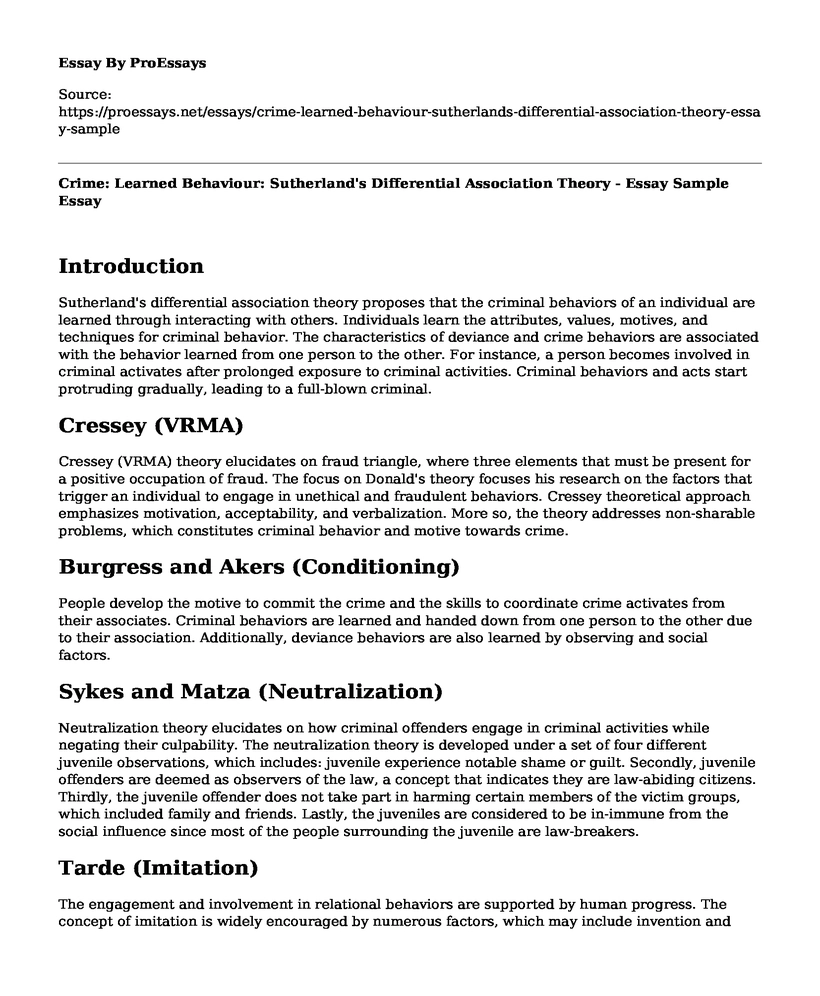Introduction
Sutherland's differential association theory proposes that the criminal behaviors of an individual are learned through interacting with others. Individuals learn the attributes, values, motives, and techniques for criminal behavior. The characteristics of deviance and crime behaviors are associated with the behavior learned from one person to the other. For instance, a person becomes involved in criminal activates after prolonged exposure to criminal activities. Criminal behaviors and acts start protruding gradually, leading to a full-blown criminal.
Cressey (VRMA)
Cressey (VRMA) theory elucidates on fraud triangle, where three elements that must be present for a positive occupation of fraud. The focus on Donald's theory focuses his research on the factors that trigger an individual to engage in unethical and fraudulent behaviors. Cressey theoretical approach emphasizes motivation, acceptability, and verbalization. More so, the theory addresses non-sharable problems, which constitutes criminal behavior and motive towards crime.
Burgress and Akers (Conditioning)
People develop the motive to commit the crime and the skills to coordinate crime activates from their associates. Criminal behaviors are learned and handed down from one person to the other due to their association. Additionally, deviance behaviors are also learned by observing and social factors.
Sykes and Matza (Neutralization)
Neutralization theory elucidates on how criminal offenders engage in criminal activities while negating their culpability. The neutralization theory is developed under a set of four different juvenile observations, which includes: juvenile experience notable shame or guilt. Secondly, juvenile offenders are deemed as observers of the law, a concept that indicates they are law-abiding citizens. Thirdly, the juvenile offender does not take part in harming certain members of the victim groups, which included family and friends. Lastly, the juveniles are considered to be in-immune from the social influence since most of the people surrounding the juvenile are law-breakers.
Tarde (Imitation)
The engagement and involvement in relational behaviors are supported by human progress. The concept of imitation is widely encouraged by numerous factors, which may include invention and opposition of ideas. Crime is inspired by motivation from opposition or innovation. Unlike born criminals who can be identified using a specific characteristic, Tarde's view elucidates that the social environment is essential in the incubation of criminal behaviors.
Glazer (Differential Identification)
The deferential identification theory asserts that a person may pursue criminal behaviors to an extent; he identifies himself with an imaginary or even real person, whose criminal behavior is deemed acceptable. Peoples' criminal behaviors are refined by the degree of interacting with other criminals. People learn crime from the ideas presented by their peers. Through this, crime is facilitated by the degree of learning and interaction.
Social Disorganization Theory
Social disorganization theory elucidates that crime is facilitated by decentralizing the society, a concept that reduces social responsibilities and monitoring of crime. Among the leading causes of social decentralization are family issues and miss understanding. Through this, it becomes easier for crime to thrive due to the lack of a centralized society. The focus of zone and territorial theories focus on the incidents happening in the community (Bellair, 2017). However, disorganization paves the way for crime, as poor coordination between the societies reduces responsibility among the members of the community.
The Three Primary Theories of Anomie/Strain Durkheim, Merton and Agnew
The focus of the strain theory explores the question of why norm breaks occur more accurately in certain societies as opposed to others. Crime arises in particular areas because of external excreted pressure, which is influenced by the unequal distribution of socio-economic resources within our community. The need to formulate and control human desire is one of the focus on Merton's approach towards limiting the level of stress to the victim, which result in criminal behaviors (Walsh, 2017). Labor division remains to be one of the leading pathological efforts to the rapid development of industrialism and inequality leading to stress, and the push for the crime. Robert Agnew's point of view on the anomie theory depends exclusively on the distribution of economic resources as the leading cause of stress.
References
Bellair, P. (2017). Social disorganization theory. In Oxford Research Encyclopedia of Criminology and Criminal Justice. doi:10.1093/acrefore/9780190264079.013.253
Walsh, A. (2017). Behavior genetics and anomie/strain theory. In Biosocial Theories of Crime (pp. 97-129). Routledge. doi.10.4324/9781315096278-4
Cite this page
Crime: Learned Behaviour: Sutherland's Differential Association Theory - Essay Sample. (2023, May 04). Retrieved from https://proessays.net/essays/crime-learned-behaviour-sutherlands-differential-association-theory-essay-sample
If you are the original author of this essay and no longer wish to have it published on the ProEssays website, please click below to request its removal:
- Ways in Which the Green Valley Developed Into a Community Essay
- Torres Vs Trivino - Paper Example
- Legal and Ethical Issues in Nursing Paper Example
- Forensic Psychological Guidelines and Ethics Essay
- Probation and Parole System: Challenges to Rehabilitation, Treatment, and Reintegration
- Developing Criminal Justice Response to Issues of Human Trafficking - Critical Essay
- Free Essay Sample on Appealing a Court Sentence: When Is it Permissible







